Updates
-

In the media April 7, 2017 0 Comments
-

Beef value chain actors reap big gains from new fi ... April 7, 2017 0 Comments
-

Deadline extended December 5, 2016 0 Comments
-
Keynote Speakers

Kennedy Dzama Head of Department and ProfessorStellenbosch University, Department of Animal Sciences

Calvin Miller Microfinance SpecialistFormerly FAO, Founder MicroVest

Karl Rich Associate ProfessorLincoln University
Presentations Livestock Finance
-
Conference proceedings book
You can now download the conference proceedings book from here.
Keynotes
- Perspectives on improving financial access for livestock value chain development: addressing the ‘missing middle’ Access to credit is a perpetual constraint cited by smallholder farmers (Swinnen and Maertens 2014). Furthermore significant gaps exist to finance agriculture in developing countries.
- Smallholder livestock production and market participation in Southern Africa: Lessons learnt This complex issue requires trans-disciplinary approaches as opposed to linear and disciplinary thinking. So far it has been looked at as an Agrisciences issue. Now we need to involve other disciplines and stakeholders.
- Models of inclusive value chain financing and investment for livestock The East Africa Dairy Development (EADD) program is designed to boost the milk yields and incomes of small-scale farmers in Africa (Kenya, Uganda and Tanzania). It helps farmers to improve dairy production and access to markets over the next two years.
Papers Session 1: Smallholders Access to Credit
- Factors affecting household decision to allocate credit for livestock production; evidence from Ethiopia Access to and proper use of agricultural credit increases agricultural production and improves rural livelihoods (Abdallah, 2016; Gatti and Love, 2006; Shimamura and Lastarria-Cornhiel, 2010) and encourages technology adoption and agricultural intensification by smallholders.
- The role of contracts in improving access to credit in the smallholder livestock sector of Swaziland Access to credit is essential for the development of the agricultural sector but banks are unwilling to participate in the provision of credit to smallholder farmers due to their lack of collateral.
- Factors influencing farmers’ uptake of credit for cattle fattening in two districts In East Java, Indonesia A presentation on factors influencing farmers’ uptake of credit for cattle fattening in two districts In East Java, Indonesia.
- Microcredit Financing in Rural Economy or Formal Banking Institutions – which has better positioned the smallholder livestock farmers for credit access in South West Nigeria There is Crucial need for Livestock financing in Nigeria in order to boost production to meet demand. Given that women contribute largely to livestock production, their need for finance in paramount, however there exist financial constraints/formal financing bias against female .It is therefore needful to assess the females' sources of livestock financing and the determinants.
- Livestock risk management to enable access of Senegalese smallholders to credit The livestock sector in Senegal contributes 30% o the agricultural GDP and 4.2% of GDP, benefiting 350,000 families and 3 million individuals.
Papers Session 2: Value Chains and Market Participation
- Influence of microfinance participation on dairy commercialisation: case of small scale dairy farmers in Kenya The emergence of MFIs in the early 1980s provided alternative institutions offering financial services to majority of Kenyans who did not have access to commercial banks.
- Value Chain Analysis of Beef in Swaziland Limited investment in community based technological innovations. Poor transactional relationships between smallholder cattle producers on SNL and other value chain actors. Inadequate and poorly coordinated public and private Partnership. Rangeland grazing management policy.
- Smallholder goat farmers’ market participation in Choma district, Zambia Despite the potential opportunities of the livestock sector,it is yet to reap the benefits due to low levels of market Participation, poor market infrastructure, lack of credit facilities, Furthermore, no research has been conducted on live goat market chain in Choma.
- A Triple-hurdle model of small ruminant production and marketing in the highlands of Ethiopia: Implications for commercial transformation Ethiopia has more than 55 million sheep and goats but falls short in both productivity measures.
- Inclusive Value Chain and Marketing among Smallholder Goat Farmers in Rural Limpopo Province, South Africa South Africa’s population is growing at almost 2 percent per year. Therefore, the population which was 49 million in 2009, is projected to rise to 82 million by 2035 (Goldblatt, undated).Given the rising population of South Africans and the attendant food demand, the demand for animals and animal products is increasing however, value addition remains a challenge (inclusiveness).Profitability of goat husbandry is dependent on transportation costs, institutional factors (policies, social constructs and cultural norms) and the willingness of the stakeholders to engage in business (trade).
Papers Session 3: Governmental Schemes and Private Funding Models
- An innovative approach to cattle fattening/finishing in Swaziland – a financial perspective The domestic cattle market is significant; Over 90% of production is absorbed domestically, despite the fact that Swaziland could benefit from preferential export to the EU.
- Rural financial services and their effects on livestock production in Ethiopia The objective of this paper is to identify the types of rural financial services and to examine their effects on livestock production in Ethiopia.
- Can value chain financing work for livestock in smallholder systems Zimbabwe Agricultural Development Trust (ZADT)’s lending strategy avoids direct lending to primary production (smallholders) to reduce risk, undermines the viability of the rest of the value chain. The model is only viable where relationships are strong, as in the case of stakeholders with over 3 years of business relationships – in such cases value chain finance has better chances of flowing indirectly to smallholder producers.
- Bridging the Financing Gaps for Small-holder Farmers in Swaziland The aim of the Rural Finance and Enterprise Development Programme (RFEDP) is to facilitate access to financial services for the rural un-banked population. This paper assesses the prevailing situation of access to finance for small-holder agriculture in Swaziland and draws lessons from the implementation of the RFEDP.
Papers Session 4: Economic Valuation of Value Chains
- Value Chain Analysis of goats in Zambia: opportunities and challenges of linking smallholders to markets Small livestock rearing in Zambia is suited for the rural farm households to invest in and take advantage of the rapid increase in income and population growth. Despite these opportunities, the small livestock sector is still underdeveloped, characterized by the limited supply of goat meat in the formal markets.
- Value Chain Analysis of Beef in Swaziland Limited investment in community based technological innovations. Poor transactional relationships between smallholder cattle producers on SNL and other value chain actors. Inadequate and poorly coordinated public and private Partnership. Rangeland grazing management policy.
- Growing a PPP : the case study of the Ngwane mills – SWADE joint venture A beef cattle value chain study (carried out by MoA/NAS TA) and a red meat market study (commissioned by Ngwane Mills) provided strong evidence that there is a solid business opportunity for a well managed livestock processing and marketing operation.
- Smallholders and livestock value chain actors access to credit in Tanzania Beef cattle fattening has been earmarked as one among several means to improve beef cattle production in Tanzania through value addition. This presentation discusses livestock value chain actors' access to credit for their business and identifies associated challenges and opportunities for improving the supply chain.
- Economic valuation of cattle value chain in Oyo State, Nigeria The livestock industry is a key contributor to Nigeria’s economy. Nigeria is one of the largest livestock keeping countries in Africa and a major hub of animal product consumption. Livestock contributes to efficient land use and crop production; employment etc.
Papers Session 5: Livestock Production, Efficiency and Marketing
- Beef cattle fattening using fodder based ration (FBR) The presentation examines the growth response of local cattle breeds finished on fodder based rations from weight of entry to weight at marketing and to identify constraints so that improvement strategies might be formulated
- Impact of access to livestock services on technical efficiency of small-ruminant production in Ethiopia Is there any considerable difference in terms of technical efficiency between producers with no access to key livestock services and those who have access to one or more of the services?
- The various problems associated with financing livestock production in Northern Nigeria The hardship in accessing funds by some of the commercial and peasant livestock farmers in the Northern region of Nigeria is significant and this is noted in the production; preservation, transportation, marketing and capital needed in the sourcing feed, kick starting of livestock production and the advanced technology needed to expand the livestock businesses.
- Market Channel Choice Decision in Botswana Cattle Markets Cattle production is the only source of agricultural exports in Botswana. Growing domestic beef demand has resulted in a shortage of beef for export. Initiating marketing cooperatives and supporting the existing ones, reducing transaction delays could improve farmers bargaining power and reduce negotiation cost
- Social networks and fodder innovations to enhance dairy cattle performance in communal areas Disintegrate fodder production from primary milk business. Social group & farmers with no dairy had better fodder yields and income. Individual farmers with no dairy -highest yields. Engage non-dairy farmers in the DVC. Minimum financial input. Sustainable.
Papers Session 6: Agricultural Credit Impact Assessment and Regional Trade
- Impact of Environmental Risk on Livestock Commodity Trade in SACU This study seeks to determine impact of environmental risks on livestock commodity trade in SACU to determine the appropriateness of finance alternatives (value chain finance)
- Disaggregated supply response of cattle and beef in Namibia: An autoregressive distributed lag approach Although Namibia has made use of the comparative advantage analogy to build an industry that has grown with meandering strides, recent data from the industry indicate that production, marketing and exportation of live cattle and beef has shown a modest growth and steady decline.
- Factors influencing communal livestock farmers’ participation into the National Red Meat Development Programme (NRMDP) in South Africa: the case of the Eastern Cape Province The National Red Meat Development Programme (NRMDP) in South Africa has so far had an immense contribution towards communal farmers’ understanding of the value of the formal market participation. However, empirical evidence to support this notion is still desirable. Hence, this case study was conducted. The objective was to determine the factors that influence farmers’ participation in the programme, focusing on the Eastern Cape Province.
- Impact of agricultural credit on livestock income: A case study of District Lasbela, Balochistan Agricultural credit facility is a key instrument for rural development; investments play a significant role in materializing a successful business venture.
- Effect of the Agricultural Credit Guaranteed Scheme Fund (ACGSF) on loan accessibility of livestock sub-sectoral productivity in Nigeria (1978-2014) The Agricultural Credit Guarantee Scheme Fund (ACGSF) was established in 1977, with the purpose of providing guarantee in respect of loans granted by any bank for agricultural purposes (CBN, 1990). This is aimed at encouraging financial institutions to lend funds to those engaged in agricultural production. The resultant effects would be to enhance export capacity of agricultural product as well as for local consumption.











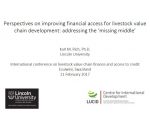


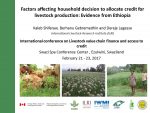
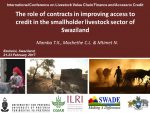
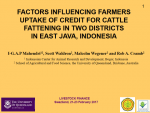
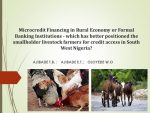



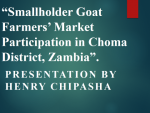




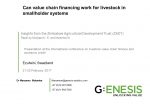
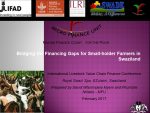
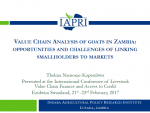

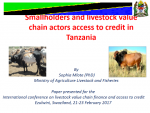



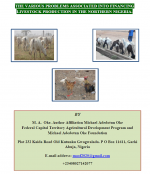
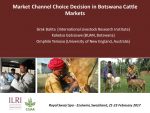
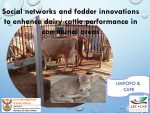

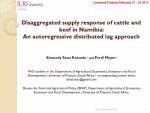
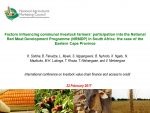

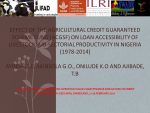



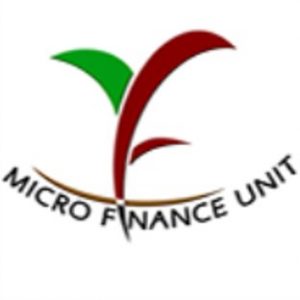

Social Media